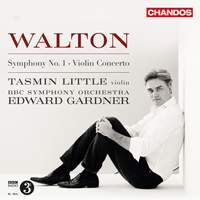Recording of the Week,
Walton from Edward Gardner and Tasmin Little
If I had to compile my personal list of the finest symphonies of the twentieth century, I’m pretty sure that William Walton's Symphony No. 1 would be very near the top. I’ve been delighted to spend my Easter weekend getting to know a new recording of the piece, due out next week, with Edward Gardner conducting the BBC Symphony Orchestra.

It was the BBC Symphony Orchestra who gave the first performance of the complete symphony in 1935. Written whilst Walton was engaged in a tempestuous relationship with the symphony’s ultimate dedicatee, Baroness Imma von Doernberg, you can certainly hear how this translates musically: the first movement is incredibly stormy and explosive, whilst the second movement, with its tempo marking of Presto con malizia, includes plenty of snarling horns, acerbic woodwind and thundering timpani.
Gardner’s speeds are pretty swift overall, especially these first two movements. If I had to pick one word to describe this recording, it would be rhythm: Gardner pays careful attention to every accent and syncopation to make the performance extremely exhilarating.
After the aforementioned malice of the second movement, Walton asks for melancholy in the third (Andante con malinconia), with its yearning, searching solos for flute and clarinet. To me the movement evokes a convulsing volcano on the brink of erupting, and Gardner captures the volatility bubbling under the movement’s surface, with churning strings and ominous trombones creating a marvellously unsettling effect.
Although the premiere of the completed symphony was in 1935, the first three movements had in fact been performed a year earlier by the London Symphony Orchestra. Walton had apparently suffered from a bout of writer’s block, unable to come up with an appropriate final movement. Indeed, a criticism sometimes levelled at the piece is that the eventual fourth movement doesn’t sit well with the first three, seeming to exist in a different sound world. While I don’t personally think of it as a problem, it is true to say that it is quite a stylistic shift (perhaps owing to the fact that he was by then in a happier relationship with Alice, Viscountess Wimborne), with Walton in much more ceremonial mode, looking forward to the pomp and pageantry of Crown Imperial and Orb and Sceptre.
The performance from the BBC players is really excellent, especially in this last movement. Again Gardner asks for a fairly nimble tempo, not just for the fugue that makes up the bulk of this movement, but also for the subsequent Vivacissimo section. Here, as indeed it is throughout the symphony, the string playing is impressively immaculate, and there’s a beautifully sweet-toned trumpet solo just before the end of the piece, despatched with seemingly effortless ease.
Also on the disc is the Violin Concerto. Commissioned by Jascha Heifetz, it was first performed in 1939, and subsequently re-orchestrated by Walton in 1943. It is this revised version that is presented here by Gardner and violinist Tasmin Little.
The 1930s were an immensely fruitful decade for violin concertos, with contributions from Barber, Bartok, Prokofiev, Britten, Hindemith, Berg, Schoenberg, Stravinsky, Szymanowski, and many others. For me, the Walton concerto easily holds its own against any of these as a fine example of the genre. Tasmin Little seems to be equally at home in the fiendishly virtuosic passagework as she is in the long, lyrical lines, such as the one that opens the concerto. It’s a very persuasive account, and makes for a fine companion to a superb recording of one of my favourite symphonies.
Tasmin Little (violin), BBC Symphony Orchestra, Edward Gardner
Available Formats: SACD, MP3, FLAC, Hi-Res FLAC



